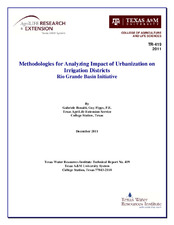| dc.description.abstract | The region of Texas along the Mexican border has been experiencing rapid urban growth. This has caused fragmentation of many irrigation districts who are struggling to address the resulting challenges. In this paper, we analyze the growth of urban area and its impact on water distribution networks in three Texas border counties over the ten year period, 1996 to 2006. In particular, we discuss alternative procedures to assess such impacts, and we evaluate their effectiveness in identifying critical areas.
Identification of urbanized areas was carried out starting from aerial photographs using two different approaches: manual identification of areas “no longer in agricultural use” and automatic extraction based on the analysis of radiometric and structural image information. By overlapping urbanization maps to the water distribution network, we identified critical areas of impact. This impact was expressed as density of network fragments per unit area, or Network Fragmentation Index (NFI). A synthetic index per each district, District Fragmentation Index (DFI) was obtained by dividing the number of network fragments by the total district length of network. Results obtained starting from manual and automatic maps were comparable, indicating that the automatic urbanization analysis can be used to evaluate impact on the water distribution network.
To further identify critical areas of impact, we categorized urban areas with the Morphological Segmentation method, using a software available online (GUIDOS). The obtained categories (Core, Edge, Bridge, Loop, Branch, and Islet) not only improved the description of urban fragmentation, but also permitted assigning different weights to further describe the impact on the irrigation distribution networks. The application of this procedure slightly shifted the areas of impact and grouped them in more easy-to-interpret clusters.
We simplified urbanization analysis by identifying a probability of network fragmentation from network and urbanization density maps. Although results were comparable to the ones obtained with the other methods, additional validation is recommended.
These methods look promising in improving the analysis of the impact of urban growth on irrigation district activity. They help to identify urbanization and areas of impact, interpret growth dynamics, and allow for partial automation of analysis. It would be interesting to collaborate with irrigation districts to determine the correlation between the real impact on the district operation and the elements of the water distribution network included in the analysis. | en |


